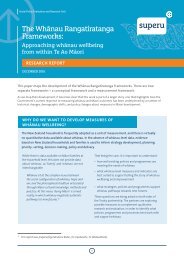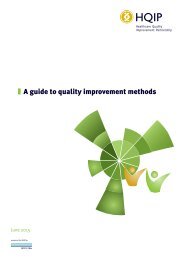2fyY1Py
2fyY1Py
2fyY1Py
You also want an ePaper? Increase the reach of your titles
YUMPU automatically turns print PDFs into web optimized ePapers that Google loves.
Researchers who are not embedded in social media companies who wish to understand the activities of young people<br />
online are hindered by two further challenges. One is the technical challenge of isolating data from young people in large<br />
datasets from digital platforms, when these are available. The other is the ethical challenge associated with using young<br />
people’s data, as accessing data, even if it is de-identified, for purposes that the individuals did not have in mind when they<br />
created them is raised regularly as an ethical concern in Internet research (173, 182–185).<br />
The challenges outlined in this section reflect a broader social and ethical challenge that is currently receiving substantial<br />
media and academic attention. In general, on the Internet, there is a stark power imbalance between the digital platforms<br />
and other social actors. The algorithms used to deliver information and advertising online are powerful and exceptionally<br />
complex and do not allow for public scrutiny (113), and the major platforms and intermediary companies engage in<br />
extensive mining of social media data and metadata of all users, including children, with “tools and systems that… are<br />
typically opaque and are rarely open to public scrutiny and supervision” (131, p. 2). This challenge is most frequently<br />
discussed in the context of Internet privacy, but it also affects those seeking to examine the digital HFSS marketing to which<br />
children are exposed.<br />
Some solutions: existing and novel methods for examining digital marketing<br />
Some of the methods previously used to explore the extent, nature and impact of food marketing in other media may be<br />
appropriate for examining these factors in digital marketing. Kelly et al. (186) give examples of the use of cross-sectional<br />
surveys (e.g. 187), qualitative focus groups (e.g. 188), cross-sectional experiments (e.g. 189) and longitudinal studies<br />
and modelling studies (e.g. 190, 191). In addition, frameworks have been designed to quantify exposure to marketing<br />
and to guide monitoring, typically for policy evaluation: the WHO framework (192), a manual from the nongovernmental<br />
organization Consumers International (193) and an academic review (194). To explore digital food marketing, as noted<br />
earlier, content analysis may be applied (195, 196), and the study designs include brand website sweeps, as described by<br />
Henry and Story (197) and Brady et al. (198). Many of the frameworks and experimental paradigms, although not overtly<br />
medium-specific, lend themselves far better to studying television advertising rather than digital marketing. Furthermore,<br />
such approaches are limited in what they can uncover about actual exposure or the extent of engagement that children<br />
have with marketing across multiple integrated online dimensions, and many do not even begin to clarify how that<br />
engagement influences real-world health behaviour.<br />
Some methods developed specifically for analysing digital media can be applied to HFSS studies. “Sentiment analysis” – the<br />
automated clustering of comments on social media and blogs and categorizing them as positive, negative or neutral – is<br />
well developed (see e.g. 199, 200). Image analysis is required for most food marketing research, which presents greater<br />
challenges for computational analysis (201), as the analytical tools that are currently easily accessible in social media are<br />
word-focused (171). As in all other instances, the major platforms are far ahead; for example, Facebook has developed<br />
sophisticated facial and other visual recognition capabilities (202). Highfield and Weaver (172) recommend, given the<br />
challenges currently inherent in visual analysis, a focus on metadata, harnessing hashtags rather than images or videos<br />
themselves, to understand “folksonomies” (folk taxonomies). One study captured children’s exposure to environmental food<br />
marketing with small, unobtrusive, wearable, automated cameras, and explored use of automated digital analysis of the<br />
images collected; this may lead to further developments in the field (203, 204).<br />
Research techniques that have been underused to date in food marketing studies may address unanswered questions in<br />
food marketing in the digital domain. Addiction studies have increased understanding of the association between exposure<br />
to salient alcohol cues and behavioural outcomes such as drinking, by measuring participants’ eye movements with eyetracking<br />
software to assess how a stimulus grabs and holds attention (attentional bias) (205). This has clear parallels with<br />
food marketing research, yet few studies have used this approach (41). Previous impediments to the use of eye-tracking<br />
in children (who must remain motionless for use of desk-mounted equipment with a fixed chin rest) no longer exist, as<br />
eye-tracking can now be built into laptops or webcams or even glasses for real-world measurement (http://www.tobiipro.<br />
com/product-listing/tobii-pro-x2-30/; http://www.eyetracking-glasses.com/). Another technique yet to be fully explored<br />
is ecological momentary assessment: repeated sampling of behaviour and experiences in real time and in real-world<br />
environments. This overcomes the limitations of retrospective self-reporting (e.g. recall bias), maximizes ecological validity<br />
and can readily be operationalized at relatively low cost by use of basic smartphone or tablet technology (206). Future<br />
18






